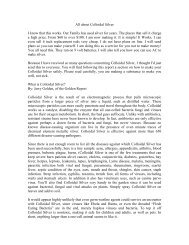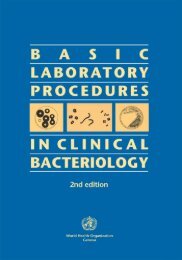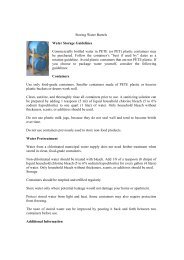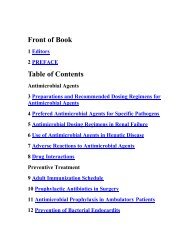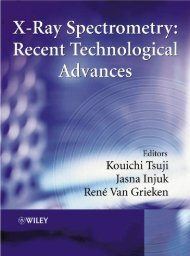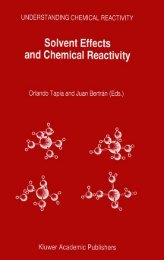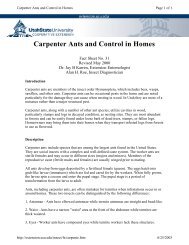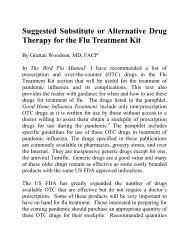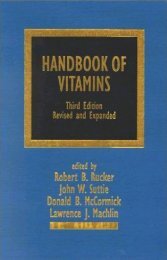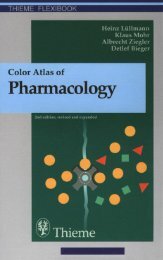The Nutritional Biochemistry of Chromium(III) - Survival-training.info
The Nutritional Biochemistry of Chromium(III) - Survival-training.info
The Nutritional Biochemistry of Chromium(III) - Survival-training.info
You also want an ePaper? Increase the reach of your titles
YUMPU automatically turns print PDFs into web optimized ePapers that Google loves.
Evaluation <strong>of</strong> chromium(<strong>III</strong>) genotoxicity with cell culture and in vitro assays 211is metabolized to Cr 3+ in the body, and Cr 3+ may be one <strong>of</strong> the ultimate speciesthat interacts with DNA in Cr 6+ -induced cancers [31, 32]. Second, the chemistry andbioavailability <strong>of</strong> Cr 3+ is altered by its coordinating ligands. For example, the Cr 3+ ionin CrPic is more bioavailable than dietary Cr 3+ ,Cr 3+ can accumulate in humans [33],and the coordination <strong>of</strong> Cr 3+ by aromatic ligands like picolinate can alter the chemistry<strong>of</strong> Cr 3+ making it more toxic than other forms <strong>of</strong> Cr 3+ [34].Carcinogenicity <strong>of</strong> a chemical is ultimately defined through human epidemiologystudies or animal experiments. However, these studies are relatively costly and timeconsuming. <strong>The</strong>refore, several cell culture and in vitro assays have been developed asscreening tools and are accepted by regulatory agencies as a first step in predictingmutagenicity or carcinogenicity <strong>of</strong> chemicals or drugs.JUSTIFICATION FOR USING CELL CULTURE AND IN VITRO ASSAYS<strong>The</strong> purpose <strong>of</strong> short-term in vitro genotoxicity assays is to predict if a chemical mayhave a potential to cause cancer and to <strong>of</strong>fer <strong>info</strong>rmation regarding chemical mechanisms<strong>of</strong> DNA damage. <strong>The</strong>se tests do not “prove” that something causes cancer, nor is thereone single test that provides an unequivocal ruling that a given substance is a carcinogen.A carcinogen is generally accepted as an agent that induces neoplasms in humans oranimals, increases the incidence <strong>of</strong> tumors, or speeds up the time for tumor development.Cancer is currently the second leading cause <strong>of</strong> death in the United States after heartdisease. Established human carcinogens include physical agents such as UV light [35],x-radiation, and gamma radiation [36], infectious agents such as hepatitis B and Cviruses [37], human papilloma viruses [38], and helicobacter pylori bacterium [39], andmany chemical agents including alcohol [40], aflatoxin [41], Cr 6+ [42], and polycyclicaromatic hydrocarbons [43].<strong>The</strong> majority <strong>of</strong> carcinogens are genotoxic (damage DNA) and mutagenic (causea permanent, heritable change in the content or structure <strong>of</strong> DNA); therefore, mostshort-term assays detect DNA damage, chromosomal damage, aneuploidy (change inchromosome number), or mutations. In vitro or cell culture assays are accepted as a“first phase” <strong>of</strong> the evaluation process for predicting carcinogenicity <strong>of</strong> a chemical, andmany guidelines have been issued to direct their use.STANDARD CELL CULTURE AND IN VITRO ASSAYS AND GUIDELINESFOR THEIR USE<strong>The</strong> protocols and guidelines for genotoxicity and mutagenicity testing have been constantlyevolving since the link between chemicals, mutagens, and carcinogens was firstdiscovered [44–48]. <strong>The</strong> history <strong>of</strong> international regulatory agency involvement and protocolstandardization has been reviewed [49]. Two <strong>of</strong> the most recent workshops devotedto international standardization <strong>of</strong> protocols were the International Workshop on Standardization<strong>of</strong> Genotoxicity Test Procedures sponsored by the International Conferenceon Environmental Mutagens in Melbourne in 1993 [50] and the International Workshopon Genotoxicity Testing Procedures sponsored by the Environmental Mutagen Society inWashington DC in 1999 [51]. Guidelines have also been issued through the International



